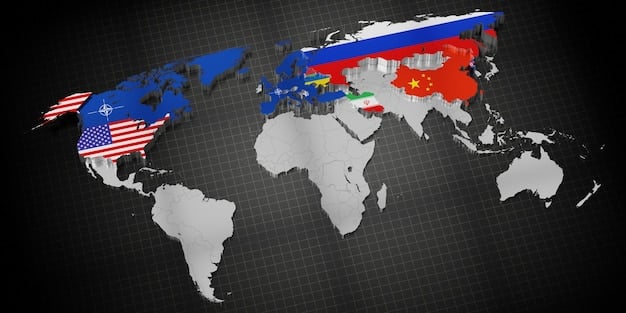US Response to Growing BRICS Influence: Strategies and Implications

The US will likely respond to the growing influence of BRICS nations through a multifaceted approach encompassing economic, diplomatic, and strategic measures to maintain its global standing.
The rise of the BRICS nations (Brazil, Russia, India, China, and South Africa) presents a complex challenge to the established global order. This article explores how will the US respond to the growing influence of BRICS nations, examining the potential strategies and long-term implications for international relations.
Understanding the BRICS Challenge to US Hegemony
The BRICS nations, representing a significant portion of the world’s population and economic output, have increasingly asserted themselves on the global stage. Their growing influence challenges the traditional dominance of the United States and Western-led institutions. This raises critical questions about how the US will adapt to this shifting geopolitical landscape.

Economic Implications of BRICS Expansion
The economic power of BRICS countries is undeniable, influencing global trade, investment, and development. Their collective GDP and growing middle class markets provide an alternative to Western-dominated economic systems.
- Trade Diversification: BRICS nations are actively seeking to reduce reliance on the US dollar through alternative trade agreements and currency arrangements.
- Investment in Infrastructure: The New Development Bank (NDB), established by BRICS, finances infrastructure projects in developing countries, competing with Western-led institutions like the World Bank.
- Technological Advancement: BRICS countries are investing heavily in technological innovation, aiming to become leaders in fields like AI, renewable energy, and digital finance.
This section explores the economic strategies that the US might implement to counter the growing strength of the BRICS economic bloc, focusing on maintaining its competitive advantage.
Diplomatic Strategies for Engagement and Containment
US diplomatic responses to BRICS involve a delicate balance between engagement and containment. While recognizing the importance of these nations in addressing global challenges, the US also seeks to safeguard its own interests and alliances.
Strengthening Alliances and Partnerships
One key strategy is to reinforce alliances with countries that share similar values and interests. This includes strengthening ties with traditional allies in Europe and Asia, as well as forging new partnerships with emerging economies outside BRICS.
The US may also use platforms like the G7 and the OECD to coordinate policies and exert influence on global issues. This approach seeks to present a united front against certain BRICS initiatives.

Promoting Democratic Values and Human Rights
Another diplomatic tool is to promote democratic values and human rights in BRICS countries and beyond. This approach aims to counter the authoritarian tendencies of some BRICS members and support civil society organizations working for political reform.
- Supporting Civil Society: Providing funding and resources to NGOs and activists promoting democracy and human rights.
- Public Diplomacy: Engaging in public diplomacy efforts to promote US values and counter disinformation from BRICS state media.
- Conditional Aid: Linking development assistance to improvements in governance and human rights records.
The article explores the potential diplomatic measures that the US might employ to engage with and manage relations with the BRICS nations, while also promoting its own values and interests on the global stage.
Military and Security Considerations in a Multipolar World
The rise of BRICS nations also raises important security considerations for the US. As these countries develop their military capabilities and assert their influence in regional conflicts, the US must adapt its defense strategies to maintain its security interests.
Maintaining a Strong Military Presence
The US may maintain a robust military presence in key regions around the world to deter aggression and protect its allies. This includes strengthening its naval presence in the Indo-Pacific region to counter China’s growing maritime power, as well as supporting its allies in Eastern Europe in the face of Russian aggression.
The US might also invest in advanced military technologies, such as artificial intelligence and cyber warfare capabilities, to maintain its military edge over potential adversaries.
Managing Regional Conflicts and Crises
The US also plays a role in managing regional conflicts and crises that could escalate into larger conflicts. This includes diplomatic efforts to mediate disputes, as well as providing military assistance to allies facing threats.
- Conflict Resolution: Engaging in diplomatic efforts to resolve conflicts in regions where BRICS nations have influence.
- Counterterrorism Operations: Continuing counterterrorism operations in areas where terrorist groups pose a threat to US interests and allies.
- Cybersecurity: Strengthening cybersecurity defenses to protect against cyberattacks from state and non-state actors.
This section discusses the potential military and security strategies that the US might implement to address the challenges posed by the growing influence of BRICS nations in the international arena.
Economic Competition and Technological Innovation
The US must compete economically with BRICS countries in key industries and technologies. This involves promoting innovation, investing in education and infrastructure, and fostering a competitive business environment.
Investing in Research and Development
One key strategy is to invest in research and development (R&D) to maintain a technological edge over BRICS nations. This includes supporting basic research in fields like artificial intelligence, biotechnology, and renewable energy, as well as promoting public-private partnerships to commercialize new technologies.
The US may also implement policies to attract and retain talented scientists and engineers from around the world.
Promoting Free and Fair Trade
Another element is to promote free and fair trade agreements that benefit US businesses and consumers. This includes negotiating trade deals that reduce barriers to trade and investment, as well as enforcing existing trade laws to prevent unfair competition.
- Trade Agreements: Negotiating new trade agreements with countries outside BRICS to diversify its economic partnerships.
- Intellectual Property Protection: Strengthening intellectual property protections to encourage innovation and protect US companies.
- Fair Trade Practices: Promoting fair trade practices to level the playing field for US businesses.
This section discusses the potential economic strategies that the US might use to compete economically with BRICS nations, focusing on innovation and fair trade practices.
The Role of International Institutions and Global Governance
International institutions like the United Nations, the World Bank, and the International Monetary Fund (IMF) play a crucial role in global governance. The US seeks to maintain its influence within these institutions to shape international norms and policies. However, the BRICS nations also seek to reform these institutions to reflect the changing balance of power in the world.
Reforming International Institutions
The US may support reforms to international institutions that make them more inclusive and representative of the interests of developing countries. This includes increasing the voting power of BRICS nations in the World Bank and the IMF.
However, the US will also resist reforms that undermine its own influence or the principles of liberal democracy.
Promoting Multilateralism and Cooperation
Another strategy is to promote multilateralism and international cooperation on issues of common concern, such as climate change, global health, and counterterrorism. This involves working with BRICS nations and other countries to find common ground and address shared challenges.
- Climate Change: Engaging in international efforts to reduce greenhouse gas emissions and mitigate the impacts of climate change.
- Global Health: Collaborating with other countries to prevent and respond to global health threats, such as pandemics.
- Counterterrorism: Working with allies to counter terrorist threats and prevent violent extremism.
This section discusses the potential role of international institutions and global governance in shaping US responses to the growing influence of BRICS nations.
Balancing Competition and Cooperation with BRICS
The US must strike a balance between competition and cooperation with BRICS nations. While recognizing the need to protect its interests and values, the US also acknowledges the importance of working with these countries to address global challenges.
Identifying Areas of Mutual Interest
One key step is to identify areas where the US and BRICS nations have mutual interests and can work together. This includes issues like climate change, global health, trade, and security.
By focusing on these areas, the US can build trust and cooperation with BRICS nations, even as it competes with them in other areas.
Establishing Clear Red Lines and Boundaries
Another element is to establish clear red lines and boundaries in its relationship with BRICS nations. This includes making it clear that the US will not tolerate actions that threaten its security interests or violate international law.
- Cybersecurity: Setting clear boundaries on cyber espionage and attacks.
- Territorial Disputes: Challenging territorial claims that violate international law.
- Human Rights: Condemning human rights abuses and supporting civil society organizations.
This section discusses how the US can balance competition and cooperation with BRICS nations, while also protecting its interests and values on the global stage.
| Key Point | Brief Description |
|---|---|
| 🌍 BRICS Influence | Growing economic and political power challenging US hegemony. |
| 🤝 Diplomatic Strategies | Balancing engagement and containment through alliances and value promotion. |
| 🛡️ Military Response | Maintaining presence and managing regional conflicts for security. |
| 💡 Economic Competition | Promoting innovation and fair trade to compete with BRICS economies. |
Frequently Asked Questions
▼
The primary challenge is the shift in global power dynamics, as BRICS nations collectively increase their economic, political, and diplomatic influence, potentially diminishing US hegemony.
▼
The US can engage by identifying mutual interests like climate change and global health, fostering dialogue, and participating in multilateral initiatives that include BRICS countries.
▼
The US can promote technological innovation, ensure free and fair trade, and invest significantly in education and infrastructure to maintain a competitive edge over BRICS economies.
▼
The US might maintain a strong military presence in key regions and invest in advanced technologies while managing regional conflicts to deter aggression and protect its interests against BRICS nations.
▼
International institutions provide a platform for both cooperation and competition, as the US seeks to maintain its influence while BRICS nations push for reforms to better reflect their growing power.
Conclusion
In conclusion, the US response to the growing influence of BRICS nations will involve a multifaceted approach encompassing economic, diplomatic, and security strategies. Balancing competition and cooperation will be crucial in navigating this evolving geopolitical landscape.





